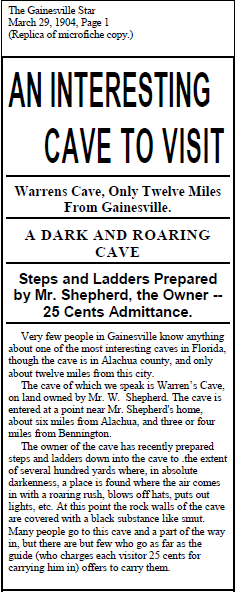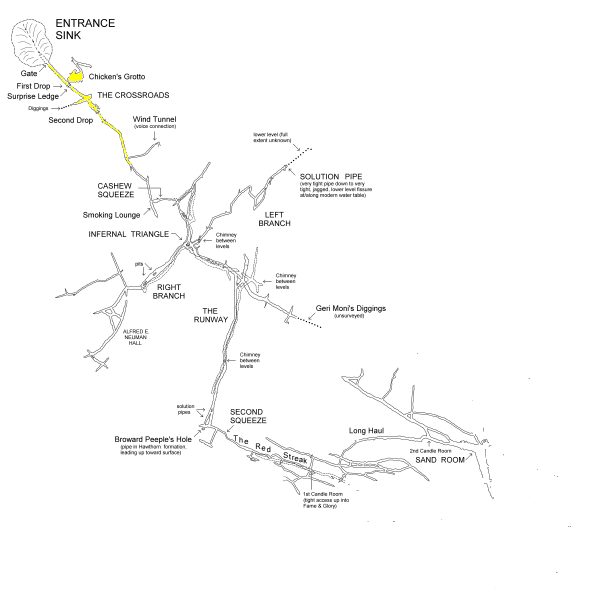EARLY HISTORY OF WARREN CAVE
During the 1830’s, Florida was embroiled in the Seminole Wars. A series of battles was fought up and down the Florida peninsula. Militia and home guard units sprang up everywhere and settlers built strategically located forts throughout the states. Among the many engagements of the wars was one which is closely tied to the history of Warren Cave. On September 11, 1836, Colonel John Warren led his men in the battle of San Felasco Hammock near the site of Warren Cave.
John Lee Williams, writing in 1837, gives this account of the battle In The Territory of Florida:
On the tenth of September a cart attended by three white men and two negroes was sent from Newmansville (near the present town of Alachua) to gather corn in a field about a mile from the village; they were fired upon by Indians. The men and Negroes escaped to the fort, but left the cart in the hands of the enemy. It was a rainy evening: the spies were sent to discover the situation and force of the enemy. They were discovered in the hammock of San Felasco four miles distant, about 300 in number.
The next morning (Sabbath) Colonel Warren marched out to attack them at the head of 150 men, 100 mounted volunteers, 25 gentlemen citizens, and 25 United States troops. He advanced in three columns, the right led by Col. Warrren, the left by Col. Wills and the centre by Capt. Tompkins with the regulars and a 24 pound howitzer. Within three quarters of a mile of the hammock they were met by the enemy, and the battle immediately commenced along the right wing and centre, while the enemy attempted to turn the left flank; but were charged with spirit by Col. Wills, who drove them into the scrub on the border of the hammock from which they were routed by the artillery, which played upon them with great effect.
Their next attempt was on the right; but they were soon driven again under range of the howitzer, which did good execution. The Indians twice charged upon the centre, to take the howitzer, but were repelled, and they were at length routed at all points and driven one and a half miles into a dense hammock (probably that in which Warren Cave lies, judging from the map in William’s book).
Whether or not Colonel Warren was actually the discoverer of Warren Cave, as local tradition claims, history at least lends some basis for the assumption. Colonel Warren did at least lend his name to the cave.
A narrow stagecoach road passed near the cave during the latter 1800’s and early 1900’s. One of the stage stops, in fact, was quite near the cave. Warren Cave came to be well-known through north-central Florida and when the USGS mapped the area in 1894, they figured Warren Cave predominately on the topographic sheet.
As it remains today, Warren Cave was a popular spot for week-end outings. Early adventurers explored the cave by the light of torches and kerosene lanterns. The soot they left on the walls and ceilings remains today — heavy up to the pit just within the entrance and almost imperceptible as you approach the end of the Historical Section. Two of these early explorers are known to have fallen to their deaths while trying to attempt to cross over the top of the pit. Sometime during the l89O’s an attempt was made to commercialize the cave and wooden ladders were installed in the pit. Needless to say, the attempt was a failure.

EXPLORATION:
From its early days in the 1800’s until 1959, Warren Cave was limited to 400 feet of passageway. This 400 foot portion of the cave is now known as the Historic Section or Old Section. At the back of the Historic Section lay a small hole in the wall from which a strong current of air frequently emitted. Early in 1959, the Florida Speleological Society (FSS) took up the task of enlarging this hole in hopes that it would lead on to more cave. Several members of the FSS worked on the hard chert walls of the hole over a period of months. Gradually the small hole grew into a skin-scraping squeeze thirty feet long. Finally, in late 1959, Bob O’Neil and Jake Hoffman made the great breakthrough. The Cashew Squeeze was opened.
Persistence and perseverance rapidly began to pay big dividends. Bob and Jake teamed up with Al Higgins and Bud Johnson to explore the new discovery. They soon revealed several thousand feet of virgin walkways, crawls, pits, and crevices on the main level of the cave. Above the the main passages, they found an extensive upper level with a few formations. From the back of this Middle Section another tight squeeze led on, further into the ridge. Three hundred feet of squeezing and crawling brought early explorers to the First Candle Room. From there still another low crawl led through a rectilinear maze and on the the Sand Room.
 (Map up to the Sand Room–Historical section shown in yellow
(Map up to the Sand Room–Historical section shown in yellow
The discovery of the Sand Room, in 1961, and the many passages leading from it led to a decision to curtail further exploration until a map could be prepared to record the work already done and to guide further exploration. From that time on, exploration and mapping were integrated and a true picture of the cave began to take form. The names of Bob Nabell, Jerry Jonson, Gary Scudder, and Jack Jarvinen figure prominently in there exploration through to 1963.
The first surveying trip was a 36-hour long ordeal which mapped all known passages through to the Sand Room–a total of 4556 mapped feet. Five years were to pass before the other three quarters of the cave were to be known. Even now the potential for new discoveries is great.
Exploration outward from the Sand Room trended north a first into a number of sand-floored passages. Later explorations led east as the Crystal Crawl and Breakdown Crawl were pushed to the Virgin Rooms. Running back to the west from the Virgin Rooms, a series of sinuous crevices and semi-vertical squeezes linked back to the Sand Room. Mapping figures mounted as this area was surveyed until the total reached 7320 feet of passage.
During the Christmas vacation of 1961-62, 26 cavers of the FSS launched a mass attack on Warren Cave. A base camp was established by the entrance and 7500 feet of telephone wire was extended back into the agonizing crawls of the cave. Several mapping parties began work on some of the most torturous crawls in the cave. This trip produced an additional 2032 feet of mapped passage, pushing the total to 9352 feet. A short time latter, in early 1962, a group of cavers disovered the Mud Section, an extensive maze of short interconnecting passages only 200 feet from the frequently visited Sand Room. Latter still, Glen Moore succeeded in enlarging and ascending a tight crack in the ceiling of the First Candle Room. He went on to discover the Fame an Glory passage to the Mud Section, a short cut which by -passes the Long Haul and Sand Room.
In the early spring of 1962 Bob Nabell made one of the most significant finds in the history of Warren Cave exploration. While on a photography trip far into the cave, Bob accidentally dropped his flashlight in the Flat Room. When he bent over to retrieve it, he felt a strong breeze blowing out from under a rock. A few minutes of work permitted the descent of a vertical crevice into a network which eventually totaled over one ad a half miles of virgin passage.
One of the early discoveries on Nabells New Discovery was the 600-Foot Long Cut, a tight, chert-lined crawlway which leads west to the Monster Room. Mapping of this passage showed that part of it approached quite close to a previously known passage. Digging in a sand-filled connecting passage opened up the connection and gave rise to the 40-foot Short Cut to the Monster Room. This little junction has saved untold hours of agony to all subsequent trips to this area and points beyond.
June, 1962 was another banner month for Bob Nabel. In that month, Bob and four companions lowered remote-controlled camera equipment down a solution pipe at the end of the Left Branch. The pictures they attained conclusively prove the existence of a lower level to Warren Cave. Unfortunately, this lower level has defied entrance. The only accesses are narrow, chert-walled crevices and solution pipes.
For a time, Warren Cave seemed to have come to an end. Not until April, 1963, was another big discovery made. At the end of a short passage leading south from near the Monster Room, a draft of cold air was detected. Pursuing the current, Jerry Johnson, Eric Walton, and Glenn More were lead into a network of passages culminating in a 26-foot deep pit at the juncture of three passages. During the summer of 1963, the telephone line was extended back several thousand feet to The Pit. Mapping was resumed and the total length of passage in Warren Cave climbed to 16,324 feet. https://www.floridacaving.com/warren-cave-history-and-exploration-part-1/Final mapping in 1963 by Bob Nabell, plus some minor additions much later, brought the total length of Warren Cave to 18,212 feet–three and one half miles.
Following the great discoveries of 1963, little new passage has been found in Warren Cave, despite much hard and diligent work on the part of Daniel Cagali, Al Krause, Jerry Moni, and many other cavers. An enormous potential for more cave still exists, however, for only a small part of the ridge has been penetrated as yet, and many leads still await the determined man.
Article reprinted from:
The Florida Speologist. October 1966, Volume 111, Number 4, Albert A Krause